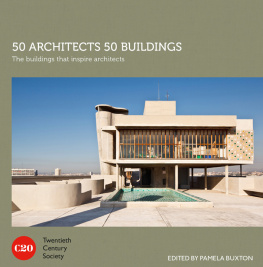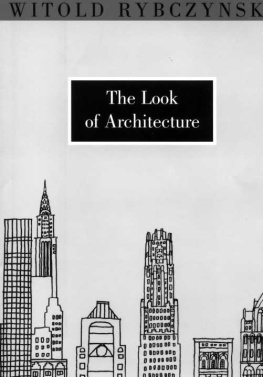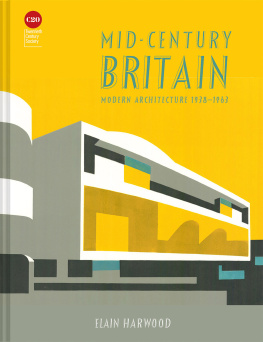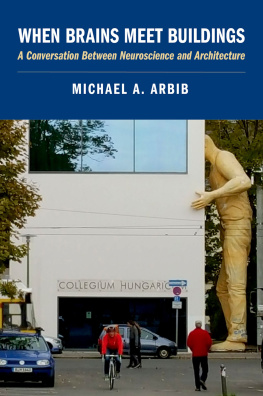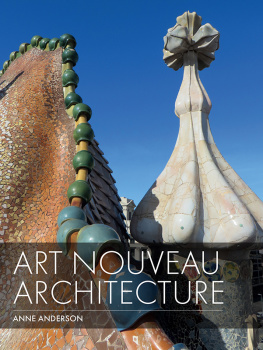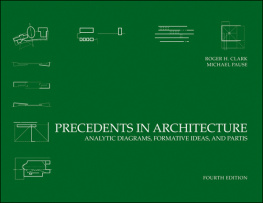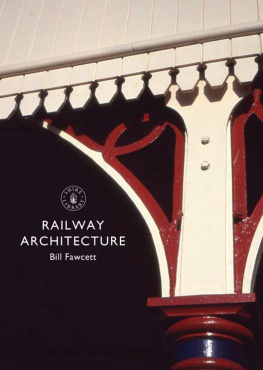50 ARCHITECTS 50 BUILDINGS
The buildings that inspire architects
50 ARCHITECTS 50 BUILDINGS
The buildings that inspire architects
Edited by Pamela Buxton
Photographs by Gareth Gardner and Edward Tyler


Introduction
Buildings that inspire architects
How do architects get their ideas? How do they learn from other peoples buildings to make their own work richer and more satisfying? Architects draw on all sorts of amazing sources, including music, fine art, numbers and nature, but all architects visit other peoples buildings, whether as a deliberate act of pilgrimage, a fact-finding mission or, inescapably, in the course of day-to-day life. For many architects, one building stands out as having had a transformative and long-term impact on their own designs. In this book architects share these often life-changing encounters with other architects amazing buildings.
Pamela Buxton had the very enviable job of taking fifty of the most interesting architects working in Britain today to visit the buildings which have inspired them most. Commissioned by the architectural publication Building Design, the records of these trips by Pamela and photographers Gareth Gardner and Edward Tyler capture the experience of each visit, and are brought together here as a collection for the first time. Together they encourage us to see these inspirational buildings afresh through an architects eyes, and understand why it was that these buildings made such an impression on them.
What does inspire mean?
Inspire was an important choice of word: the participants were not asked to pick their favourite building, or to attempt to select a best building indeed sometimes difficult and flawed buildings are more inspiring than perfect ones. To inspire means to fill someone with the urge or ability to do or feel something, especially to do something creative. Some participants describe their choices as profoundly moving or feeling like coming home the sort of analogies we draw when talking about finding a human soul mate. Although they could have taken Building Design to gothic cathedrals or baroque palaces, the majority looked back no further than the beginning of the last century, and picked C20 buildings. The architecture of the C20, and modernism in particular, seems to be what excites todays architects most.
First encounters
What is the first building you can remember being in? Many of our earliest memories are of places and the emotions they provoked. Im struck by the fact that many of the architects here choose buildings they have known for an extremely long time and, not surprisingly, many initially encountered the buildings they selected in architectural books and magazines, and first visited them themselves as students, sometimes returning again and again over subsequent years. But some go even further back. James Soane picks the Liverpool Playhouse Extension; not a very famous building, but one to which he feels an intensely autobiographical relationship. Not only was it conceived in the same year as he was, but his father was its engineer, and had a picture of it over his desk. James recalls how it entered into my consciousness before I even knew what architecture was and made me aware of modern architecture before I knew anything about it.
Another native Liverpudlian, Paul Monaghan, picks Liverpools Roman Catholic Cathedral, Paddys Wigwam a building he admires because it is really loved by the public, and is where his whole school went for services. Niall McLaughlin chooses the building that made me want to be an architect, ABKs Trinity College Dublin Library, and he recounts how he was all set to study English at university until he looked carefully at this building, and its extraordinary vividness had such an impact on him that he changed to study architecture.
Many architects are enthusiastic travellers, and young architects often take work abroad, sometimes for their year out the year (or more) spent working in architects offices between undergraduate and post graduate study architectural education is a long haul. Many of the buildings selected here were first seen at this point, and some of our architects had personal encounters with their heroes. Edward Jones first went to Eliel Saarinens Cranbrook campus to take life-drawing classes when he was working for Eliels son Eero for a summer that must have led to some interesting conversations. Chris Williamson had a spell working in New York, and then headed west to California where in 1980 he could wander into the garden of the Eames House and find Ray Eames still living and working there. Some of the first encounters were casual or even illicit (theres some squeezing though hoardings, and climbing over locked gates recalled here). But some architects had very formal introductions: Michl Cohen went to the newly completed Hellerup School on a British Council study trip and was shown round by the head teacher. Some architects went alone, some with their colleagues, some added on a visit as a treat after teaching in a new city, or visiting a site for a forthcoming project. I suspect the itineraries of some family holidays were tweaked to take in a special place, somewhere long lodged in the subconscious or freshly spotted in a journal.
Revisiting
All these circumstances and more impact on how a place affects us, and going back with Pamela and a photographer specifically for this project was always going to be a different experience. Many participants reflect on these differences, and how they and the places have changed. Some first visits were made when buildings were brand new architecture, some have now shifted status to be regarded as historic buildings. Sometimes the original use has weathered this change; sometimes buildings now have a very different role. There are buildings that have decayed while others have been spruced up and restored. Some architects are uneasy about over-restoration, some would love to get the job of sweeping away disfiguring accretions, or sorting out those little bits that in their opinion never worked in the first place. Perhaps most surprisingly Jon Buck and Dominic Cullinan chose somewhere they had never actually been before, and made their first ever trip to Leicester Engineering Building. Might it have inspired them differently if they had actually visited earlier?
How do buildings inspire architects?
The hardest question these encounters raise is exactly how these buildings have inspired the architects who have selected them. Some of them talk directly about this: Sean Griffiths is provocatively flippant when he tells us that FAT has nicked many ideas [from Loos American Bar]. Jonathan Ellis-Miller is now amused at how blindingly obvious the influence of Hopkins has been on his firms work in terms of plan, aesthetic and organisation of space. There is a bit a self-deprecation there, but also an innate self confidence that each has added something extra and created something new. In contrast, Tony Fretton is adamant that he cant see any Asplund influences in his own work. And, of course, architects and critics can have different interpretations of what is going on. Sometimes we remain so close to something we have created ourselves that we cant see it remotely objectively.
Building an inner library
The late Jonathan Woolf went to see the Krefeld Villas to study brickwork for a commission where he chose to use brick for the first time, but few of these buildings have been so consciously picked out for individual project research. I like Tim Ronalds reflection that he returns to Gothenburg Law Courts not so much to copy ideas or forms directly, rather to recharge my aspirations. Others talk of a specific buildings as a touchstone, a reference, a pin-up for us or as a starting point. Borrowings, of whatever form, may be recognised and acknowledged at the time, or only realised much later. Biba Dow says she can only now see subliminal analogies between her choice of inspirational building and the practices own work. Marie-Jos van Hee talks about how a building goes right into your inner map, your personal library, and you never know when and how it will come out again until it does.
Next page
